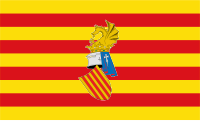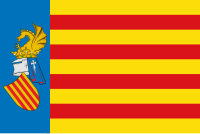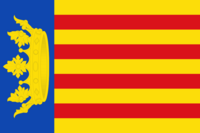Flag of the Valencian Community
The flag of the Valencian Community, also called real señera, crowned señera, señera with blue, tricolor señera or Valencian señera, is described in article 4 of the Statute of Autonomy of the Valencian Community and in article 2 of law 8/1984 of the Generalitat Valenciana of December 4, which regulates the symbols of the Valencian Community and their use.
Originally, this was the flag of the city of Valencia, there is currently a huge controversy as to whether it was the flag of the kingdom of the same name, and since 1982, after a long identity conflict, it became the Official flag of the Valencian Community.
It is the only flag in the world with the rank of royalty, that is, it does not bow before anyone or anything, except God. It receives military honors with twenty-one cannon salutes and, when it is lowered from the Valencia City Hall on October 9, it does so completely vertically. This rank was granted by Pedro the Ceremonious in the year 1377, after Valencia's resistance to the attack of the troops of Pedro the Cruel, in the well-known war of the Two Pedros.
History of the flag of the Valencian Community
After the end of the Franco regime, the Pre-autonomous Council of the Valencian Country, with a socialist majority and leaders influenced by the nou valencianisme, adopts the four-barred emblem without a crown, with the emblem of the Generalitat on the center as the official flag of the pre-autonomous entity, hoisting in the Palace of the Generalitat and also on the balcony of the Valencia City Hall together with the crowned flag, then the city's flag, on April 24, 1979. During these years there will be a tough and intense struggle around the flag, between the supporters of the quadribarrada with the emblem of the Generalitat, who requested for the territory the denomination of the Valencian Country and the defenders of the crowned and flag of the city of Valencia until that moment, supporters of the traditional denomination of the Kingdom of Valencia. The reaction of the right, in favor of the sign with a blue stripe, was violent, and the councilor for the UCD of Valencia, Rafael Orellano, arrived to devise a way to set fire to the sign of the Pre-autonomous Council of the Valencian Country during the institutional acts of the 9th of October 1979.
Finally, the negotiations on the Statute of Autonomy of the Valencian Community led, with the consensus of all the participating Valencian political parties with the exception of the PCPV, in the Benicasim Pact of 1981, whose agreements included the adoption of a new consensual symbol, a sign with the shield of the Generalitat on the blue stripe on the pole, as the official flag of the autonomous community, with the name of the Valencian Country.
Subsequently, said draft Statute was extensively modified by the Madrid Congress of Deputies in 1982, to the point of breaking the previous Valencian political consensus, and the proposed flag was changed to the crowned flag, as well as the term of Country Valencian, which was replaced by that of the Valencian Community, at the proposal of UCD deputy Emilio Attard, who years later would classify his own proposal as pejorative.
Story of the crowned lady
Its meaning in the Middle Ages
Pedro the Ceremonious, in recognition of the resistance offered by Valencia to Pedro the Cruel of Castile during the War of the two Pedros (1356-1365), grants the City of Valencia the right to use the crown on its weapons real.
This privilege is referred to in a document collected in the following quote:
"E es cert quel senyal per los molts alts Reys darago atorgat e confermat a la dita Ciutat era e es lur propri senyal Reyal de bastons o barres grogues e verlles. [...] [L]o molt alt senyor Rey ara Regnant per son propri motiu e sa mera liberalitat tenint se aixi com fon sa merce per molt servit de la dita Ciutat senyaladament en la guerra de Castella prop passada specialment en los dos Setges e pus principalment en lo segon e derrer daquells tengutConsells Manual of 1377 (Archivo Histórico Municipal de Valencia, years 1375-1383, n. 17, sig. A)
"And it is true that the sign by the very high Kings of Aragon granted and confirmed to the City was and is its own Royal sign of yellow and red sticks or bars. [...] The very high Lord King now reigning for his own initiative and mere generosity, thus considering His Merced how it was well served by the city markedly in the recent war of Castile, especially in the two sieges and more mainly in the second and last of those made on it [Valencia] by the King of Castile added the crown to the said sign"
Thus, therefore, it would initially be a heraldic banner that evolved until it took the form of a flag, with a crown on the bars of the kings of the Crown of Aragon.
The existence of this crown has been demonstrated since the XV century thanks to the large number of portulans in which it was displayed, either as an additional flag on blue (Vallseca 1439), or together with the bars within a blue strip next to the pole (Roselli 1466, anonymous from 1473), or crowning the flag vertically (Joan Martínez 1540), tracing its respective masts over the City of Valencia.
The first known representation of a crowned sign on a portolan appears to have taken place as early as 1410 (approx.), on an anonymous portolan kept in the National Library of France, Paris.
On May 31, 1449, the Municipal Council ordered that, given the deterioration of the old landmark (the Pendón de la Conquista supposedly given by Jaime I to the City of Valencia, which would pass to monastic custody until 1838), this is replaced by a new similar sign but with a crown:
«[...] attenets that the flag d'or e flama, fos squiurada and worn, so provide ne fos feta a nova consemblant of that, but ab Corona»Consells Manual, Municipal Historical Archive of Valencia, A-34, fol CC, years 1447-50
The existence of a blue stripe next to the pole would have been reflected in the expenses memorial written by Mestre Racional for the making of the señera in the years 1503, 1545 and 1596, which mentions the use of "tella d'or wide for the crown of the dita bandera ab tafatà de grana i blau" (1545) or "tafatà de mantós blau for the pole and crown of the dita bandera i setí crimson i mig palm de setí vert pear the gemstones of the crown» (1596), although this blue cloth could also have been used for the cape of the helmet that is reflected in the shield of Peter the Ceremonious, equally blue, and that was placed at the end of the pole.
Anyway, there is no unanimity among historians on this last point: Manuel Sanchis Guarner will consider that the original color of the stripe with the crown is unknown and that it became blue around 1850, and even some authors, such as Pere M Orts, go so far as to state that both the crown and the blue stripe would be the result of a mid-century modification XIX (Previously, the crown would not have been embroidered on the signature, but would have been limited to the metal piece, with the drac-alat or bat on top, which is currently displayed at the end of the pole of the current Real Señera that is conserved in the Municipal Historical Archive of Valencia).
At that time there were no flags as territorial symbols, but heraldic banners of kings, nobles, and towns. Thus, the flag of the City of Valencia would reflect its coat of arms, already with the honorary award of the crown from Pedro the Ceremonious. During medieval times, the subjects of the villas of royal heritage, followed after the Royal Señera, that is, the four sticks of gules, symbol of the king; those of señoríos followed the ensign of the cross of San Jorge, symbol of the army of the nobility; and those of the City of Valencia had the privilege and honor of following their own flag, probably the only private one that existed at that time, which was hoisted on the Torres de los Serranos. The honor was such that later the crowned lady was assigned a specific military unit for her escort and protection, the Knights of the Hundred of Plumbs.
A sector of historiography emphasizes the complete absence of the Crowned Señera in the paintings of the Palace of the Generalitat (circa 1590), in which all the señeras appear without the crown, as one of the proofs that the The flag of the old Kingdom of Valencia was the same as the King's, and not the City's.
19th century
Much later, during the XIX century, coinciding with the economic boom of the city of Valencia and its area of influence, the historic "orange region" (from Burriana to Denia), the crowned señera became popular in that area, until shortly before the XX century, Valencianism politician claimed it as a symbol of the Valencian Country, not only of the city of Valencia. However, outside of the "orange region" The only historically known symbol of the Valencian Country continued to be considered, which is that of the Kingdom of Valencia and, therefore, the royal flag, without a crown or stripe on the pole, but said territorial symbol was previously adopted by Catalonia during the II Republic.
Civil war and Francoism
During the Civil War, the tricolor flag became popular in the military propaganda of the Republican side, and was hoisted in Ibiza, which was taken over by the Valencian Republicans during the Landing of Majorca. After the end of the conflict, in the victory parade of the rebel side, in Madrid in 1939, both flags were displayed as war trophies, along with other symbols such as the ikurriña. During the Franco dictatorship, the use of both symbols was highly protected, so that they were used in a very restricted way as folkloric waste, and the Franco authorities made sure, for example, that they were not used during the preparations for the Fallas in Valencia., threatening the members of the Junta Central Fallera with one day in prison for each "secessionist flag" to be displayed on the balconies in the streets of the city.
At the end of the dictatorship, in the 1960s, with the resurgence of political Valencianism, despite its break with all the symbols and approaches of pre-war Valencianism, the Valencian academic Manuel Sanchis Guarner convinced the Francoist authorities to the crowned flag will cease to be prohibited, and will be legally adopted as the flag of the City of Valencia. In addition, this time the nou valencianisme influences the three provinces, not only in the "orange region", a fact that influenced the adoption of the Señera Real, the quadribarrada without blue stripe or crown, as a symbol of what a sector of the population will call the Valencian Country, since it was known by all Valencians, while the crowned sign was still known only by a part.
The flag of the Valencian Community today
Currently, the crowned flag generates a certain amount of rejection among certain nationalist-pan-Catalanist left-wing parties (Esquerra Republicana del País Valencià, Candidatura de Unidad Popular) and other left-wing parties (EUPV, Els Verds, Iniciativa del Poble Valencià[citation required]), which uniquely identifies it as the flag of the city of Valencia. There are sectors that prefer the flag with the blue stripe as an autonomous symbol and the term Valencian Country, in the case of the Bloc Nacionalista Valencià that assumed it as its own in its last congress. On the other hand, from sectors of the Pan-Catalanism, supporters of the crowned lady have been attacked, accusing them of being fakers and far-rightists.
At the beginning of 2006, the Congress of Deputies began to process the new Statute of Autonomy of the Valencian Community, agreed by the two majority parties, PP and PSOE-PSPV. This new Statute was approved in April 2006 by the Valencian Parliament by a majority of 84 votes in favor and 5 against. In it, the Señera Coronada or Senyera Valenciana is established as a flag, in the same terms as the previous one.
Design
The Valencian Señera or Crown Señera, is established as follows: «The Flag of the Valencian Community is the traditional "Señera&# 3. 4; composed of four red bars on a yellow background, surmounted by a blue stripe next to the pole.»
The flag does not have fixed official proportions, but two forms are used de facto, 1:2 and 2:3. The first form is considered to be the traditional one, being used above all in buildings with great historical symbolism and at high levels, which makes this size the most solemn. The use of the second size, on the other hand, is more widespread because the size of the flag of the Valencian Community may not be greater than that of Spain, nor less than that of other entities when they fly together.
Simplified version
The simplified version of the Valencian señera arises by eliminating the added heraldic elements, in this case, the crown. Its use is common in forms, posters, indicators, and other visual representations that make it difficult to show the trademark in all its linear complexity. It is represented without a vertical red stripe, since it is also part of the crown.















